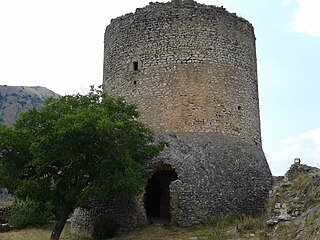
The House of Piccolomini is the name of an Italian noble family, Patricians of Siena, who were prominent from the beginning of the 13th century until the 18th century. The family achieved the recognized titles of Pope of the Catholic Church, Prince of the Holy Roman Empire, Grandee of Spain, and Duke of Amalfi. The family is also featured in Florentine Histories, a book written by Niccolò Machiavelli, where he describes the reign of Pope Pius II, who had allied himself with the Venetians and Prince Vlad Dracula, to wage a war against the Sultan of the Ottoman empire.

Pietro Giannone was an Italian philosopher, historian and jurist born in Ischitella, in the province of Foggia. He opposed the papal influence in Naples, for which he was excommunicated and imprisoned for twelve years until his death.

Celano is a town and comune in the Province of L'Aquila, central Italy, 120 km (75 mi) east of Rome by rail.

Giugliano in Campania, also known simply as Giugliano, is a city and comune (municipality) in the Metropolitan City of Naples, Campania, Italy. A suburb of Naples, as of 2017, it had some 124,000 inhabitants, making it the most populated Italian city that is not a provincial capital.

Popoli Terme is a comune and town in the province of Pescara, in the Italian region of Abruzzo.

The Diocese of Altamura-Gravina-Acquaviva delle Fonti is a Latin Church diocese of the Catholic Church in Apulia, southern Italy, 40 km south-west of the coastal city of Bari. In 1986. the territorial prelature of Altamura e Acquaviva delle Fonti was united with the diocese of Gravina. The present diocese is a suffragan of the archdiocese of Bari-Bitonto.
The Conti di Marsi, the Counts of Marsi, were a lineage of Frankish origin who figured among the main feudal lords of Abruzzo, part of the Duchy of Spoleto in southern Italy, during the eleventh and twelfth centuries.

Tourism in Abruzzo has become one of the most prosperous sectors in the economy of Abruzzo, and in recent years has seen a remarkable growth attracting numerous tourists from Italy and Europe. According to statistics, in 2021 arrivals totaled 1,330,887. A total of 5,197,765 arrivals were tourists, a figure that puts the region seventeenth among the Italian regions for numbers of tourists per year. A moderate support to tourism is also given to the Abruzzo Airport with many low cost and charter flights connecting the entire region with the rest of Europe.

Castello Piccolomini is a castle in Celano, Province of L'Aquila (Abruzzo).

Castello di Ocre is a medieval castle in Ocre, Province of L'Aquila, Abruzzo, southern Italy.

Castello di Oricola is a medieval castle in Oricola, Province of L'Aquila (Abruzzo).

Castello di Ortona dei Marsi is a Middle Ages castle in Ortona dei Marsi, Province of L'Aquila (Abruzzo).

Castello di Salle is a Middle Ages castle in Salle, Province of Pescara, Abruzzo, Italy.

Museo d'Arte Sacra della Marsica is a museum of religious art in Celano, Province of L'Aquila (Abruzzo).
The War of L'Aquila was a conflict in 15th-century Italy. It started in 1423 as a personal conflict against the condottiero Braccio da Montone and the city of L'Aquila in Abruzzo, but later turned into a national conflict when the forces of the Duchy of Milan, the Republic of Florence, the Papal States, and the Kingdom of Naples were also involved. Braccio da Montone was killed in the final battle near L'Aquila.

Camillo Tutini was an Italian historian, mainly of the Neapolitan region.

Asmundo is an old Sicilian noble family that has played a notable role in the island's political, cultural, and economic history.
The Di Sangro family is an Italian noble family.

The Vico, and Vicoletto, dei Zuroli, also called Vicolo dei Zurli are two historic alleys in the city of Naples, they are located near Via Forcella in the historic center of the city, near the church of Pio Monte della Misericordia, between Via dei Tribunali and Via Vicaria Vecchia, in the Pendino district.


















